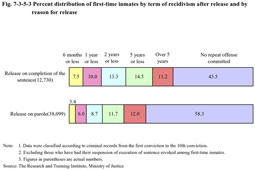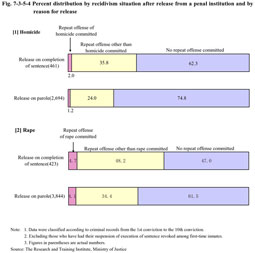| Previous Next Index Image Index Year Selection | |
|
|
3 The recidivism situation after the release of first-time inmates
Fig. 7-3-5-3 shows the presence or absence of a subsequent conviction and the term of recidivism by reason for release from a penal institution (limited to parole and release from prison on completion of sentence term) with regard to first-time inmates (excluding those who had their suspended execution of sentences revoked) with the 700,000 Non-Repeat and Repeat Offenders' Recorded Convictions.
Fig. 7-3-5-3 Percent distribution of first-time inmates by term of recidivism after release and by reason for release With parolees, the rate of conviction for a repeat offense after release is low when compared to that of those released from penal institutions on completion of a sentence, with their terms of recidivism also being long.Also, in regard to homicide and rape which are serious offenses, Fig. 7-3-5-4 shows the percent distribution by presence or absence of subsequent convictions after release by reason for release from a penal institution. Fig. 7-3-5-4 Percent distribution by recidivism situation after release from a penal institution and by reason for release With both homicide and rape, the ratio of those without a repeat offense is high, particularly when compared with the ratio for overall offenses as shown in Fig. 7-3-5-3. Also, with parolees, the rate of committing a repeat offense after release is low when compared with those released on completion of term of sentence.As mentioned above, with parolees, the rate of committing repeat offenses (including serious offenses) after release is low when compared with those released on completion of term of sentence, with the term of recidivism also being long. This reveals that the parole examinations had been appropriately conducted based on assessment of their risk of recidivism and that their community-based treatment had been properly carried out. However, there are indeed persons who committed repeat offenses among those released from penal institutions on parole, and in the future, further examination should be required from various points of view in order to conduct parole reviews more appropriately. |

